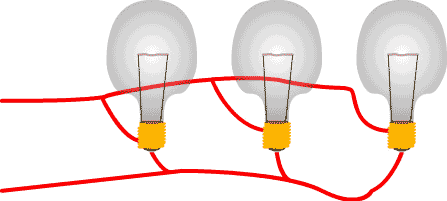Electricity and Power page 3 of 6
Types of Circuits
There are two primary types of electrical circuit: series and parallel.
Series circuit

Advantage: Less expensive and easier to wire.
Disadvantage: Less reliable. If one goes out, they all go out.
Parallel circuit

Advantage: More reliable.
Disadvantage: More expensive and takes longer to wire. If one goes out the others stay on.
Switches must be wired as if part of a series circuit. When adding a switch to a parallel circuit; that circuit type is now considered a "combination circuit".A switch acts as a "circuit breaker" in that it literally breaks the flow of current regardless of how the rest of the circuit is wired.
Combination Circuit
Switch added to a parallel circuit.

Series Circuit (with a switch)
Switch added to a series circuit.

Most of the equipment and cabling in the theatre uses 3 wires; a "hot", a "neutral", and a "ground". Because most of our equipment is "AC" (alternating current, which is described in the next segment), the hot and neutral are somewhat interchangeable, but the ground must always be isolated.
Thick cables, which have an outer insulator around smaller wires with insulation, are typically labeled.
What does 12/3 mean? 12 gauge = 20amp capacity – 3 means 3 cables inside. 16/2 means 16 gauge / 6amps with 2 cables.
Inexpensive home extension cords are often 18/2 = 18 gauge / 3amps with 2 cables. That's only good for 160 watt capacity!
Inexpensive home extension cords are often 18/2 = 18 gauge / 3amps with 2 cables. That's only good for 160 watt capacity!

Photos are of 12/3 cable. Inside the large rubber insulation are 3 separate 12 gauge cables each in their own plastic insulation. The cables are made of separate strands which makes them more flexible and less brittle (as compared to solid core cable).
Green always stands for "ground". Black or red = "hot", and white = "neutral".
The ground wire, eventually, runs to: "the ground"! Remember that the Earth is a great ball of positive energy, which is why lightning aims for the ground! Ground circuits are usually connected to a cable that leads into the earth – so that if something goes wrong, the extra power is led safely to a positive source – hopefully avoiding doing damage or hurting people because that is the 'path of least resistance' to a positive source.
Connectors (also known as plugs) come in a wide variety of styles. Generally, in America, they come in a few standard types:
Edison are the most common household connector in the United States.
Edison connectors are often made by a process of "plastic mold injection" which offers no easy process for maintenance. Others tend to have many screws and are often bulky.
- Note:
- The bottom / curved pin is always the ground.
Twist lock connectors come in different formats; they may be of different sizes – and their locking "nipple" or "flag" may be facing either "in" or "out".The advantage of "twist-lock" connectors is that they don't fall apart easily or accidentally. The negative is that they are bulky, have many screws to open them, and their different options can cause confusion.
- Note:
- With twist-lock connectors, the pin with the flag is always the ground.
Stage pin (sometimes called "3-pin") connectors are the most commonly used type in the industry because they use less screws/lower maintenance, the connections inside are more clearly laid out, and they lie flat – which is less of a tripping hazard than twist locks.Because the terminals are neatly laid out next to each other; it's usually easier to find / repair problems than with other connector types.

Adapters (like this Stage-pin plug to Edison socket) are useful for using non-standard equipment with your system.
- Note:
- The center pin (which is longer than the other 2) is always the ground.

Adapters (like this Stage-pin plug to Edison socket) are useful for using non-standard equipment with your system.










